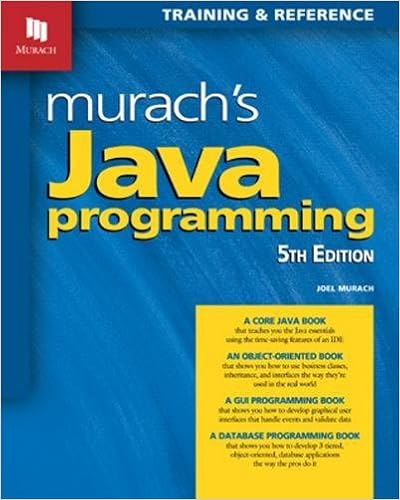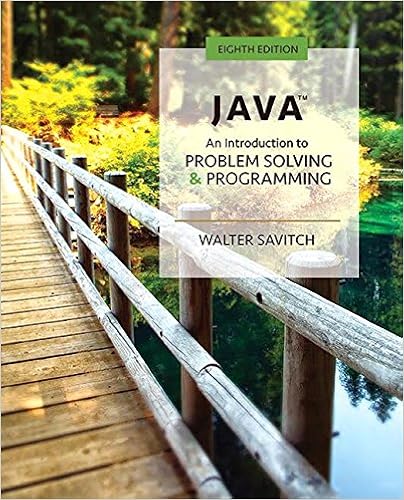Assembly Programming Language is a low-level programming language for computer and other programmable device. Each Assembly Programming Language is specific to a particular computer architecture.
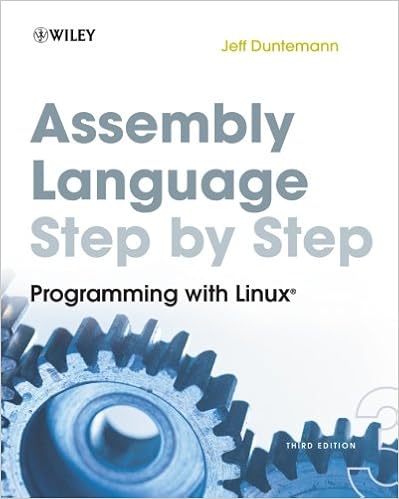 Assembly Language Step-by-Step: Programming with Linux
Assembly Language Step-by-Step: Programming with Linux – The Assembly Language Step-by-Step: Programming with Linux 3rd Edition book, by Jeff Duntemann is bestselling introduction to x86 assembly language. The long-awaited third edition of this bestselling introduction to assembly language has been completely rewritten to focus on 32-bit protected-mode Linux and the free NASM assembler. Assembly is the fundamental language bridging human ideas and the pure silicon hearts of computers, and popular author Jeff Dunteman retains his distinctive lighthearted style as he presents a step-by-step approach to this difficult technical discipline. He starts at the very beginning, explaining the basic ideas of programmable computing, the binary and hexadecimal number systems, the Intel x86 computer architecture, and the process of software development under Linux. From that foundation he systematically treats the x86 instruction set, memory addressing, procedures, macros, and interface to the C-language code libraries upon which Linux itself is built. Serves as an ideal introduction to x86 computing concepts, as demonstrated by the only language directly understood by the CPU itself. Uses an approachable, conversational style that assumes no prior experience in programming of any kind. Presents x86 architecture and assembly concepts through a cumulative tutorial approach that is ideal for self-paced instruction. Focuses entirely on free, open-source software, including Ubuntu Linux, the NASM assembler, the Kate editor, and the Gdb/Insight debugger. Includes an x86 instruction set reference for the most common machine instructions, specifically tailored for use by programming beginners. Woven into the presentation are plenty of assembly code examples, plus practical tips on software design, coding, testing, and debugging, all using free, open-source software that may be downloaded without charge from the Internet. Learn assembly language, and you learn the machine, In this third edition of his bestselling guide to Intel x86 assembly language under Linux, Jeff Duntemann positions assembly not as unapproachable geek arcana but as a first programming language, suitable for readers who have no previous programming experience. As the fundamental language of the CPU, assembly lays the groundwork for all other programming languages, especially native-code C, C++, and Pascal. By mastering assembly, programmers will learn how x86 computers operate all the way down to “the bare silicon,” at a level of detail that no other approach can equal.
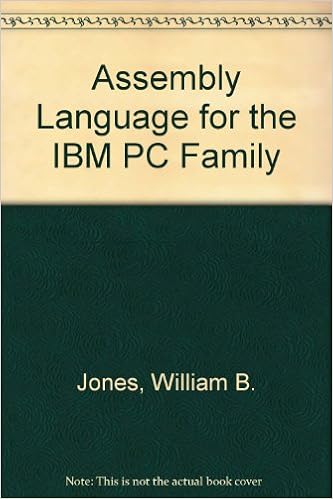 Assembly Language Programming for the IBM PC Family
Assembly Language Programming for the IBM PC Family – Assembly Language Programming for the IBM PC Family 2nd Packag Edition by William B. Jones includes the following features: NEW TO THIS EDITION:; New substantial chapter on using the Floating Point Unit, including I/O routines for floating point numbers in the library.; More coverage of debuggers, including added exercises in which code must actually be fixed. Discussed primarily in separate “chapters” called Debug Workshops, both TASM and MASM are treated in parallel and in greater detail.; More emphasis on C and C++ as example of high-level languages.; Information on use of the shareware Windows-based editing program WinEdit, as well as the author’s own included editor, for programming in assembly language.; New material on generation of libraries (the LIB and TLIB programs).; Coverage of internal formats of instructions, micro-optimization (at the assembly level), CISC vs. RISC architectures, cache memories, prefetch queues, and other hardware topics, including distinct features of the Pentium CPU. Well rounded introduction to assembly language for the IBM PC. The explanations have some depth, but are easy to follow. No excessive code listings, just enough to illustrate the ideas. A step by step through the basics and then goes further. It is a complete assembly language course for the IBM PC.
 Modern X86 Assembly Language Programming: 32-bit, 64-bit, SSE, and AVX
Modern X86 Assembly Language Programming: 32-bit, 64-bit, SSE, and AVX – Modern X86 Assembly Language Programming: 32-bit, 64-bit, SSE, and AVX 1st ed. Edition by Daniel Kusswurm shows the fundamentals of x86 assembly language programming. It focuses on the aspects of the x86 instruction set that are most relevant to application software development. The book’s structure and sample code are designed to help the reader quickly understand x86 assembly language programming and the computational capabilities of the x86 platform. Major topics of the book include the following: 32-bit core architecture, data types, internal registers, memory addressing modes, and the basic instruction set. X87 core architecture, register stack, special purpose registers, floating-point encodings, and instruction set. MMX technology and instruction set. Streaming SIMD extensions (SSE) and Advanced Vector Extensions (AVX) including internal registers, packed integer arithmetic, packed and scalar floating-point arithmetic, and associated instruction sets. 64-bit core architecture, data types, internal registers, memory addressing modes, and the basic instruction set. 64-bit extensions to SSE and AVX technologies. X86 assembly language optimization strategies and techniques. Daniel Kusswurm has over 30 years of professional experience as a software developer and computer scientist. During his career, he has developed innovative software for medical devices, scientific instruments, and image processing applications. On most of these projects, he successfully employed x86 assembly language to significantly improve the performance of computationally-intense algorithms or solve unique programming challenges. His educational background includes a BS in Electrical Engineering Technology along with an MS and PhD in Computer Science. This book is absolutely brilliant – a systematic coverage of all main families of the x86 instruction set, from the core instructions to the latest AVX. Unlike in some other programming books, all code sample projects are current, and everything I have tried worked out of the box. My only suggestion is to prepare a version of this book that works on Linux. This book is Windows-only, with the Intel syntax of the assembly, because the MASM is used throughout. On Linux, NASM should be able to use the same Intel syntax but the calling conventions are different. I am planning to try to convert some of the samples from this book to work on Linux using the advice from Agner Fog’s manuals. With the AVX512 now available in mainstream processors, and most (all?) high level languages being unable to exploit it, the assembly once again becomes the only route to utilizing the processor resources to the max. Integrates C with assembly in the examples. Really good coverage and explanations compared with many other assembly languages texts I’ve read. I was able to run them in early and more recent versions of MS Studio without a problem.
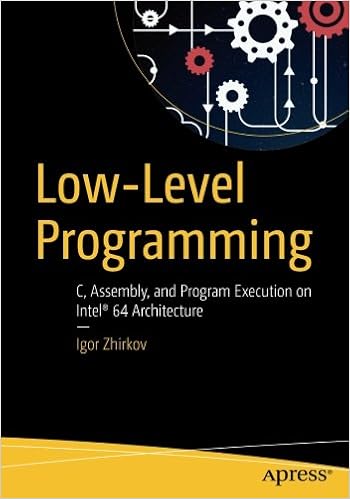 Low-Level Programming: C, Assembly, and Program Execution on Intel® 64 Architecture
Low-Level Programming: C, Assembly, and Program Execution on Intel® 64 Architecture – With Low-Level Programming: C, Assembly, and Program Execution on Intel® 64 Architecture 1st ed. Edition, by Igor Zhirkov Book you will learn Intel 64 assembly language and architecture, become proficient in C, and understand how the programs are compiled and executed down to machine instructions, enabling you to write robust, high-performance code. Low-Level Programming explains Intel 64 architecture as the result of von Neumann architecture evolution. The book teaches the latest version of the C language (C11) and assembly language from scratch. It covers the entire path from source code to program execution, including generation of ELF object files, and static and dynamic linking. Code examples and exercises are included along with the best code practices. Optimization capabilities and limits of modern compilers are examined, enabling you to balance between program readability and performance. The use of various performance-gain techniques is demonstrated, such as SSE instructions and pre-fetching. Relevant Computer Science topics such as models of computation and formal grammars are addressed, and their practical value explained. What You’ll Learn: Freely write in assembly language. Understand the programming model of Intel 64. Write maintainable and robust code in C11. Follow the compilation process and decipher assembly listings. Debug errors in compiled assembly code. Use appropriate models of computation to greatly reduce program complexity. Write performance-critical code. Comprehend the impact of a weak memory model in multi-threaded applications. Who This Book Is For? Intermediate to advanced programmers and programming students. Igor Zhirkov teaches his highly successful “System Programming Languages” course at ITMO University in Saint Petersburg. He studied at Saint Petersburg Academic University and received his master degree from ITMO University. Currently, he is doing research in verified C refactorings as part of his PhD thesis and formalization of Bulk Synchronous Parallelism library in C at IMT Atlantique in Nantes, France. His main interests are low-level programming, programming language theory, and type theory. Very well written book on Intel 64 architecture and programming using both Assembly language and C. Clear instructions, numerous code samples compilable from the first try and many assignment forcing the reader to apply his newly acquired knowledge to writing useful and quite complicated code from scratch. The chapters on using C and Assembly in ensemble are especially valuable. There are many good books about C but this one is the best I’ve seen so far on Assembly and its productive use with C. Buy this book if you’re interested in the underlying principles of low-level programming. The book is good for those with some experience who seek to learn basic concepts of low-level programming while systematizing their gut feelings of programming patterns and good practices into a coherent view.
 Introduction To 80X86 Assembly Language And Computer Architecture
Introduction To 80X86 Assembly Language And Computer Architecture – The Revised and Updated Edition of the Introduction To 80X86 Assembly Language And Computer Architecture 3rd Edition, by Richard C. Detmer is a classic text guides students through assembly language using a hands-on approach, supporting future computing professionals with the basics they need to understand the mechanics and function of the computer’s inner workings. Through using real instruction sets to write real assembly language programs, students will become acquainted with the basics of computer architecture. 80×86 Assembly Language and Computer Architecture covers the Intel 80×86 using the powerful tools provided by Microsoft Visual Studio, including its 32- and 64-bit assemblers, its versatile debugger, and its ability to link assembly language and C/C++ program segments. The text also includes multiple examples of how individual 80×86 instructions execute, as well as complete programs using these instructions. Hands-on exercises reinforce key concepts and problem-solving skills. Updated to be compatible with Visual Studio 2012, and incorporating over a hundred new exercises, 80×86 Assembly Language and Computer Architecture: Third Edition is accessible and clear enough for beginning students while providing coverage of a rich set of 80×86 instructions and their use in simple assembly language programs. The text will prepare students to program effectively at any level. Key features of the fully revised and updated Third Edition include: • Updated to be used with Visual Studio 2012, while remaining compatible with earlier versions • Over 100 new exercises and programming exercises • Improved, clearer layout with easy-to-read illustrations • The same clear and accessibly writing style as previous editions • Full suite of ancillary materials, including PowerPoint lecture outlines, Test Bank, and answer keys • Suitable as a stand-alone text in an assembly language course or as a supplement in a computer architecture course. If all you’re looking for is a no fuss book on how to code in x86 Assembly, then this book’s for you. I have looked through other x86 books that spend too much time focusing on hardware, assembly translations and mathematics instead of focusing on how to code. In this edition, Detmer primarily uses Visual Studio with his own custom plug-ins (downloadable from the publisher’s website) to walk you through the chapters. Visual Studio’s provides excellent debugger tools to monitor register values, memory, and to analyze code line by line. Detmer also provides good walkthroughs on what the code is doing behind the scenes. Unlike guides from other books, I have had no problems setting up my computer to code and analyze x86 assembly. The programming problems are also excellent and help reinforce the material you just learned.
 Professional Assembly Language
Professional Assembly Language – Professional Assembly Language by Richard Blum. Unlike high-level languages such as Java and C++, assembly language is much closer to the machine code that actually runs computers; it’s used to create programs or modules that are very fast and efficient, as well as in hacking exploits and reverse engineering. Covering assembly language in the Pentium microprocessor environment, this code-intensive guide shows programmers how to create stand-alone assembly language programs as well as how to incorporate assembly language libraries or routines into existing high-level applications. Demonstrates how to manipulate data, incorporate advanced functions and libraries, and maximize application performance. Examples use C as a high-level language, Linux as the development environment, and GNU tools for assembling, compiling, linking, and debugging. Every high level language program (such as C and C++) is converted by a compiler into assembly language before it is linked into an executable program. This book shows you how to view the assembly language code generated by the compiler and understand how it is created. With that knowledge you can tweak the assembly language code generated by the compiler or create your own assembly language routines. This code-intensive guide is divided into three sections — basics of the assembly language program development environment, assembly language programming, and advanced assembly language techniques. It shows how to decipher the compiler-generated assembly language code, and how to make functions in your programs faster and more efficient to increase the performance of an application. You will learn from this book: The benefits of examining the assembly language code generated from your high-level language program. How to create stand-alone assembly language programs for the Linux Pentium environment. Ways to incorporate advanced functions and libraries in assembly language programs. How to incorporate assembly language routines in your C and C++ applications. Ways to use Linux system calls in your assembly language programs. How to utilize Pentium MMX and SSE functions in your applications.
 Assembly Language for x86 Processors
Assembly Language for x86 Processors – Assembly Language for x86 Processors 7th Edition by Kip R. Irvine is intended for use in undergraduate courses in assembly language programming and introductory courses in computer systems and computer architecture. This title is also suitable for embedded systems programmers and engineers, communication specialists, game programmers, and graphics programmers. Proficiency in one other programming language, preferably Java, C, or C++, is recommended. Written specifically for 32- and 64-bit Intel/Windows platform, this complete and fullyupdated study of assembly language teaches students to write and debug programs at the machine level. This text simplifies and demystifies concepts that students need to grasp before they can go on to more advanced computer architecture and operating systems courses. Students put theory into practice through writing software at the machine level, creating a memorable experience that gives them the confidence to work in any OS/machine-oriented environment. Additional learning and teaching tools are available on the author’s web site at http://asmirvine.com/ where both instructors and students can access chapter objectives, debugging tools, supplemental files, a Getting Started with MASM and Visual Studio 2012 tutorial, and more. This book will help you to Teach Effective Design Techniques: Top-down program design demonstration and explanation allows studentsto apply techniques to multiple programming courses. Put Theory into Practice: Students will write software at the machine level, preparing them to work in any OS/machine-oriented environment. Tailor the Text to Fit your Course: Instructors can cover optional chapter topics in varying order and depth. Support Instructors and Students: Visit the author’s web site http://asmirvine.com/ for chapter objectives, debugging tools, supplemental files, a Getting Started with MASM and Visual Studio 2012 tutorial, and more. This book is one of the very best book on Assembly Language. It’s great in explain how assembly language works.
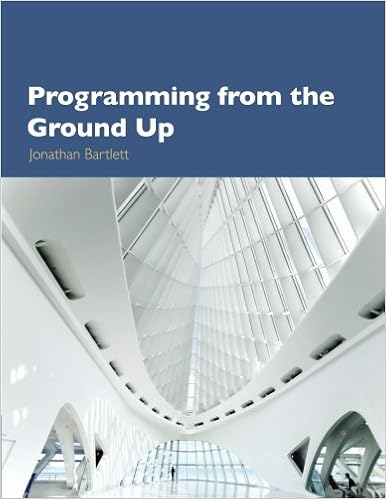 Programming from the Ground Up
Programming from the Ground Up – Programming from the Ground Up Paperback by Jonathan Bartlett is an introductory book to programming and computer science using assembly language. It assumes the reader has never programmed before, and introduces the concepts of variables, functions, and flow control. The reason for using assembly language is to get the reader thinking in terms of how the computer actually works underneath. Knowing how the computer works from a “bare-metal” standpoint is often the difference between top-level programmers and programmers who can never quite master their art. The book is licensed under GNU FDL. We were excited to publish this book for several reasons. First of all, very few books on assembly language deal with the Linux platform. In fact, most of the ones in use today are either stuck teaching MS-DOS 16-bit assembly language or teaching the MIPS architecture assembly language. Neither of these is particularly useful in modern programming, and 16-bit x86 assembly language is a complete nightmare for new programmers. This book fills a real need right now. It is the only book available that (a) is readable by new programmers, (b) focuses on the cleaner 32-bit assembly language, (c) targets the Linux platform, and (d) uses the tools that are available standard on Linux distributions. The other Linux assembly language books require downloading and installing third-party assemblers, while this book uses the one that comes with the gcc tool chain. This book also fills a need in the industry. Right now there are numerous programmers who either never got a formal education or went to a school that did not require assembly language programming. When you don’t understand assembly language, you miss out on learning how the computer thinks and acts underneath the hood. This book has helped numerous programmers come back and learn assembly language and really understand how the computer works. If assembly language has been a “black magic” subject for you, this book will help you out. –This text refers to an out of print or unavailable edition of this title. Absolutely AMAZING book for learning Assembly, one of the best book to read. Great book to the introduction of low-level programming in assembly. A fantastic introduction to memory addressing and memory allocation too. great knowledge on ultra-low-level programming concepts. This one of the best books in your technical library.
 Introduction to 64 Bit Windows Assembly Programming
Introduction to 64 Bit Windows Assembly Programming – Introduction to 64 Bit Windows Assembly Programming by Ray Seyfarth book introduces programmers to 64 bit Intel assembly language using the Microsoft Windows operating system. The book also discusses how to use the free integrated development environment, ebe, designed by the author specifically to meet the needs of assembly language programmers. Ebe is a C++ program which uses the Qt library to implement a GUI environment consisting of a source window, a data window, a register window, a floating point register window, a backtrace window, a console window, a terminal window, a project window and a pair of teaching tools called the “Toy Box” and the “Bit Bucket”. The source window includes a full-featured text editor with convenient controls for assembling, linking and debugging a program. The project facility allows a program to be built from C source code files and assembly source files. Assembly is performed automatically using the yasm assembler and linking is performed with ld or gcc. Debugging operates by transparently sending commands into the gdb debugger while automatically displaying registers and variables after each debugging step. The Toy Box allows the use to enter variable definitions and expressions in either C++ or Fortran and it builds a program to evaluate the expressions. Then the user can inspect the format of each expression. The Bit Bucket allows the user to explore how the computer stores and manipulates integers and floating point numbers. Additional information about ebe can be found at http://www.rayseyfarth.com. The book is intended as a first assembly language book for programmers experienced in high level programming in a language like C or C++. The assembly programming is performed using the yasm assembler automatically from the ebe IDE under the Linux operating system. The book primarily teaches how to write assembly code compatible with C programs. The reader will learn to call C functions from assembly language and to call assembly functions from C in addition to writing complete programs in assembly language. The gcc compiler is used internally to compile C programs. The book starts early emphasizing using ebe to debug programs. Being able to single-step assembly programs is critical in learning assembly programming. Ebe makes this far easier than using gdb directly. Highlights of the book include doing input/output programming using Windows API functions and the C library, implementing data structures in assembly language and high performance assembly language programming. Early chapters of the book rely on using the debugger to observe program behavior. After a chapter on functions, the user is prepared to use printf and scanf from the C library to perform I/O. The chapter on data structures covers singly linked lists, doubly linked circular lists, hash tables and binary trees. Test programs are presented for all these data structures. There is a chapter on optimization techniques and 3 chapters on specific optimizations. One chapter covers how to efficiently count the 1 bits in an array with the most efficient version using the recently-introduced popcnt instruction. Another chapter covers using SSE instructions to create an efficient implementation of the Sobel filtering algorithm. The final high performance programming chapter discusses computing correlation between data in 2 arrays. There is an AVX implementation which achieves 20.5 GFLOPs on a single core of a Core i7 CPU. A companion web site, http://www.rayseyfarth.com, has a collection of PDF slides which instructors can use for in-class presentations and source code for sample programs.
 X86 Assembly Language and C Fundamentals
X86 Assembly Language and C Fundamentals – X86 Assembly Language and C Fundamentals 1st Edition by Joseph Cavanagh. Assembly Language is the predominant language used in embedded microprocessors, assembly language lets you write programs that are typically faster and more compact than programs written in a high-level language and provide greater control over the program applications. Focusing on the languages used in X86 microprocessors, X86 Assembly Language and C Fundamentals explains how to write programs in the X86 assembly language, the C programming language, and X86 assembly language modules embedded in a C program. A wealth of program design examples, including the complete code and outputs, help you grasp the concepts more easily. Where needed, the book also details the theory behind the design. Learn the X86 Microprocessor Architecture and Commonly Used Instructions. Assembly language programming requires knowledge of number representations, as well as the architecture of the computer on which the language is being used. After covering the binary, octal, decimal, and hexadecimal number systems, the book presents the general architecture of the X86 microprocessor, individual addressing modes, stack operations, procedures, arrays, macros, and input/output operations. It highlights the most commonly used X86 assembly language instructions, including data transfer, branching and looping, logic, shift and rotate, and string instructions, as well as fixed-point, binary-coded decimal (BCD), and floating-point arithmetic instructions. Get a Solid Foundation in a Language Commonly Used in Digital Hardware. Written for students in computer science and electrical, computer, and software engineering, the book assumes a basic background in C programming, digital logic design, and computer architecture. Designed as a tutorial, this comprehensive and self-contained text offers a solid foundation in assembly language for anyone working with the design of digital hardware. The author Joseph Cavanagh is an adjunct professor in the computer engineering department at Santa Clara University in California. This book is one of the best texts on the market for learning Assembly Language. This book is a big book 800+ pages but explains everything very clearly and has detailed answers to many questions in the back of the book.
 Guide to Assembly Language: A Concise Introduction
Guide to Assembly Language: A Concise Introduction – The book Guide to Assembly Language: A Concise Introduction 2011th Edition by James T. Streib will enable the reader to very quickly begin programming in assembly language. Through this hands-on programming, readers will also learn more about the computer architecture of the Intel 32-bit processor, as well as the relationship between high-level and low-level languages. Topics: presents an overview of assembly language, and an introduction to general purpose registers; illustrates the key concepts of each chapter with complete programs, chapter summaries, and exercises; covers input/output, basic arithmetic instructions, selection structures, and iteration structures; introduces logic, shift, arithmetic shift, rotate, and stack instructions; discusses procedures and macros, and examines arrays and strings; investigates machine language from a discovery perspective. This textbook is an ideal introduction to programming in assembly language for undergraduate students, and a concise guide for professionals wishing to learn how to write logically correct programs in a minimal amount of time. Recommended for all readers levels. It teaches assembly language with precision and verve, and it also provides the reader with some understanding of the computer architecture that drives assembly language. This book is an excellent text for a course in assembly language programming, and for programmers who want to understand the low-level operations and constructs that underlie high-level languages. Its attention to machine issues also makes it suitable as a supplemental text in a course on computer operations or architecture. This book to Assembly Language will enable the reader to very quickly begin programming in assembly language. Through this hands-on programming, readers will also learn more about the computer architecture of the Intel 32-bit processor, as well as the relationship between high-level and low-level languages. The book can either be used as a stand-alone text in a one-semester course on assembly language, or as a supplementary text in a computer organization and architecture course. You will learn: Presents an overview of assembly language, and an introduction to general purpose registers. Illustrates the key concepts of each chapter with complete programs, chapter summaries, and exercises (with answers to selected exercises provided in the Appendices). Covers input/output, basic arithmetic instructions, selection structures, and iteration structures. Introduces logic, shift, arithmetic shift, rotate, and stack instructions. Discusses procedures and macros, and examines arrays and strings. Investigates machine language from a discovery perspective. Provides an overview of binary and hexadecimal, logic, and arithmetic in the Appendices, together with a Glossary, and a section on Visual C++ and MASM.










